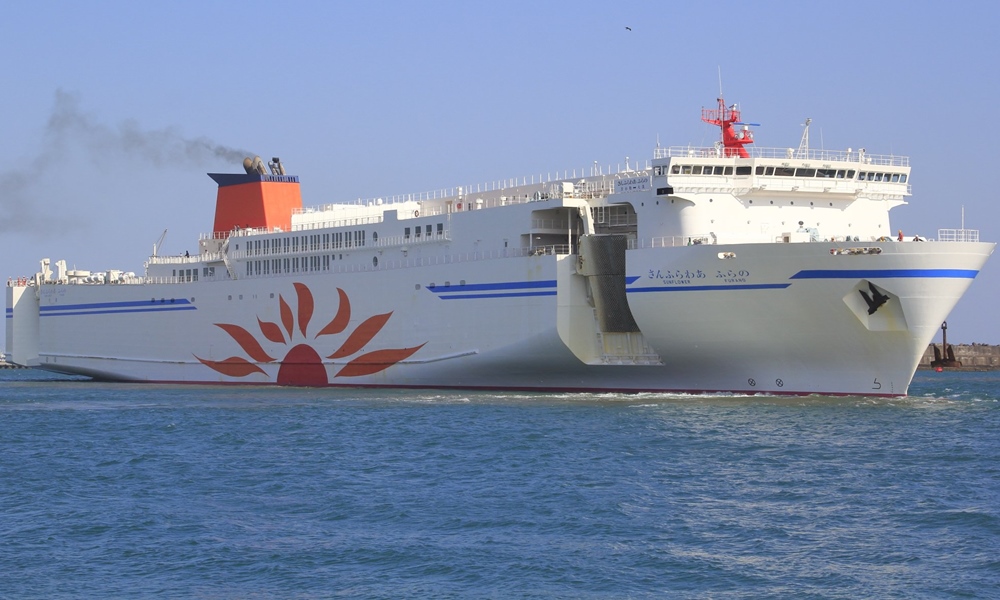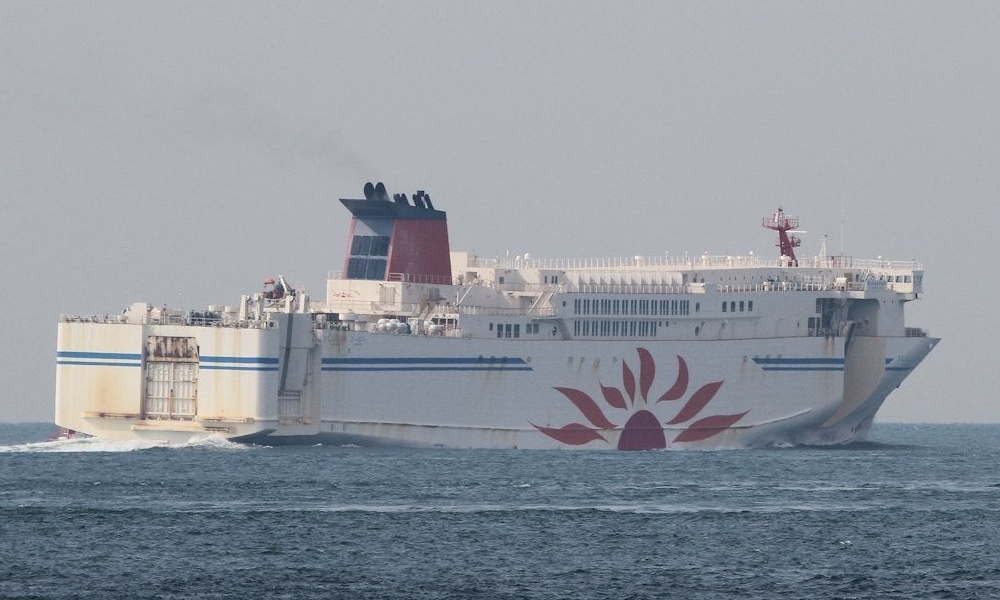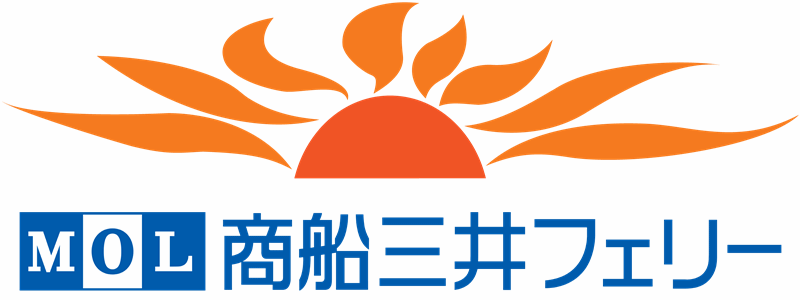Sunflower Furano ferry
Sunflower Furano ferry current position
The current location of Sunflower Furano ferry is in East Asia cruising at speed of 21.9 kn (41 km/h | 25 mph) en route to Sapporo-Tomakomai. The AIS position was last reported 1 minute ago.
Current PositionSpecifications of Sunflower Furano ferry
| Year of build | 2017 / Age: 8 |
| Flag state | Japan |
| Builder | JMU-Japan Marine United Corporation (Isogo-Yokohama, Japan) |
| Class | cruiseferry (Ro-Pax ship) |
| Ferry route / homeports | Oarai-Tomakomai/Sapporo City |
| Engines (power) | Wartsila (21 MW / 28161 hp) |
| Speed | 24 kn / 44 km/h / 28 mph |
| Length (LOA) | 200 m / 656 ft |
| Beam (width) | 27 m / 89 ft |
| Gross Tonnage | 13816 gt |
| Passengers | 636 |
| Crew | 46 |
| Cars | 146 |
| Freight vehicles | 160 |
| Decks | 8 |
| Cabins | 97 |
| Decks with cabins | 3 |
| Sister-ships | Sunflower Sapporo |
| Owner | Mitsui OSK Lines Ltd (via Mitsui OSK Passenger Line) |
| Operator | MOL Ferries Ltd (via MOL Ferry Co Ltd) |
Sunflower Furano ferry Review
Review of Sunflower Furano ferry
Sunflower Furano ferry is a Ro-Pax/Ro-Ro passenger vessel operated by the Japan-based company MOL FERRIES (subsidiary of Mitsui OSK Passenger Line). The ship has a max capacity of 636 passengers and cargo capacity 146 cars plus 160 lorries (semi-trailers/13-meter-long trucks). The vessel was inaugurated in 2017 (May) and currently operates on the Honshu-Hokkaido ferry route Oarai-Tomakomai/Sapporo City (route distance 470 mi / 755 km) with crossing/ship travel time 18 hours.
Departures from Oarai are at 7:45 pm, and the arrival in Tomakomai is at 1:30 pm (on the next day).
Ferry Sunflower Co Ltd operates the Oarai-Tomakomai route since 1993. Since 2017, on the same route is also deployed the sistership Sunflower Sapporo.
The vessel (IMO number 9761542) is currently Japan-flagged (MMSI 431009293) and registered in Osaka.

Sunflower Furano in Japanese is さんふらわあ ふらの
The new ferry's name honors the old Sunflower Furano (1993-built as "Hestia", IMO 9061590) having 9 decks, max passenger capacity 703 and max cargo capacity 100 vehicles plus 180 trucks.
The old Furano ship was built for Higashi Nihon Ferry (in service 1993-2007) and later was acquired by Libera Corporation (2006-2007), MOL Ferry (2007-2017) and Atosim Lampung Pelayaran (since 2018). Since 2017, the old namesake is named GOLDEN PEARL III (Mongolia-flagged/MMSI 457900323) and is homeported in Panjang.
Decks and Cabins
The cruise ferry Sunflower Furano has a total of 97 staterooms, all which are fitted with individual air conditioners, TVs, and refrigerators, kettles. and most are with en-suite bathrooms.
The passenger accommodations include 1x Balcony Suite, 20x Premium Balcony Rooms, 68x Superior Rooms, 5x Pet Cabins, 6x Comfort Rooms (with sleeping capsules for 20-32 people), 3x Tourist Rooms (with folding mattresses and partition curtains, for 11-25 people), and 70x Truck Driver Cabins (single occupancy).
All passenger cabins are air-conditioned, bathrooms are fitted with WC-toilet, washbasin, shower, hairdryer, hangers, trash can, cups. MOL Ferries provides bed linens, service towels, and toiletries (toothbrushes, hand soap).
The new Furano ship has 21x balcony cabins, all of which are with wheelchair-friendly bathrooms (with bathtubs) and with private step-out terraces, each furnished with two deckchairs. The five Whizpet Rooms ("Superior With Pet Room" cabin category) have linoleum flooring. Private Single cabins (トラック乗務員様専用スタンダードシングル) target truck drivers and are with shared bathrooms). Private Bed cabins are with indoor stairs access (to the upper beds). Tourist Bed cabins are Group Japanese-style rooms with floor bedding.
Like all new Sunflower ships, Furano has a Dog Run (outdoor dog exercise area) and expanded (3 times larger in comparison to the old namesake) onboard shopping space.
The boat has 8 decks, of which 3 are with public venues and staterooms and 5x are garage decks (for wheeled cargo/passenger vehicles and trucks).
Shipboard facilities and amenities
Onboard facilities include a large public bath, a restaurant (buffet-style dining venue), a cafe lounge (exclusive for passengers in the top-tier suites on Deck 8), an indoor playground (kids' corner), Baby Changing Room, Public Restrooms, exclusive to Truck Drivers facilities (Bathhouse, Cafeteria/Restaurant, Salon/Bar Lounge).
Next are listed Sunflower Furano cruise ship's staterooms, venues and facilities by deck.
Midship on Deck 7 (階) are located all Balcony Rooms (1x Western-style Suite plus 19x Premium) and 1x Barrier-Free Suite (with large round windows) which is also wheelchair-accessible. Forward on Deck 7 is the bow-facing Navigation Bridge/Wheelhouse and the adjacent Captain's Suite and officers' quarters. From the passenger accommodations section is accessed (via aft stairs) an open-air Observation Deck (展望デッキ).
On Deck 6 (階) are located an Observation Deck with two Assembly Stations (aft portside and starboard), Buffet Restaurant (レストラン / with table seats, counter seats, baby chairs, Western/Japanese/Chinese dishes, separate Children's Menu), Game Corner (ゲームコーナー / arcade machines and toys-claw machines), Truck Driver Restaurant/Cafeteria (ドライバー食堂) as well as passenger accommodations in categories Superior (スーペリア客室).
On Deck 5 (階) are located the Boarding Hall (Atrium's Lobby with Reception Desk, Information Office, Souvenir Shop, digital signage board), Kids' Land (indoor playground), two Grand Baths (large public bathhouses, separate for men 紳士展望浴場 and women 婦人展望浴場, each with 1x Sauna, 2x spa pools/hot tubs, 3x large windows, changing cubicles, washrooms), exclusive Truck Driver facilities (Bathhouse and Salon/Bar Lounge) Shower Room (24-hours open private showers), Baby Care Room (ベビーケアルーム, diaper changing room for babies, has a water heater), Ladies' Powder Room (化粧室, half bath in the women's restroom, has with a large mirror and a powerful haidryer), 2x Pet Cage Rooms (ペットケージルーム / with 12x cages, 1x washbasin, trash bins, air-conditioner), Dog Run (ドッグラン / outdoor dog exercise area accessed via stairs from both Cage Rooms), as well as passenger accommodations in categories Superior, Comfort (Private Bed), Tourist (Group Private Bed) and Standard Single (Truck Driver Rooms).
Pet Cage Rooms are at charge and pre-cruise reservations are required. Pet cages are medium-sized (55x53x72 cm).
The Grand Bathrooms are free of charge. However, passengers with tattoos/tattoo seals and body art paintings as well as dead-drunk passengers are not allowed in the wellness facilities.
The Promenade (midship-starboard on decks 5-6) is Japan's first one-sided Atrium on a cruise ship. This is an indoor deck space with an open floor design, an Atrium Lounge with starboard views (from large round windows), comfortable seating (leather sofas, small tables with armchairs and pouf chairs lined up by the round-shaped large windows).
The 2-story Atrium (decks 5-6) has large round windows on each floor and the lower and upper levels are interconnected via a grand staircase and an elevator. On Deck 5 (by the Atrium staircase) is the Photo Gallery with seating. The Photo Corner is for Sunflower cruise-themed selfies and pictures taken in front of a large panel (on the hull). Sailor uniforms and hats are provided complimentary to both adults and children.
The Shop sells shop has a wide selection of Sunflower-logoed merchandise (including toys and puzzles), also food and beverages (including alcohol), clothing, convenience goods/daily necessities, presents, souvenirs.
There are plenty of coin lockers, PIN lockers (for valuables) and paid refrigerated lockers (for foods/beverages) located across the Reception Desk. Coin return lockers are 64 (6x Large, 40x Medium, 18x Small). Refrigerated paid lockers are 8 (sized 30x36x34 cm).
The ship also has coin laundry facilities (each fitted with 3x washing machines/JPY 300, 3x dryers/JPY 100, detergent is added automatically), 1x smartphone charging station (JPY 100), 1x pay phone.
On Decks 5 and 6 are located vending machines selling canned beverages (soft drinks, water, alcohol/sake, beers), cup noodles, packaged snacks.
Buffet Restaurant's pricing (2023-updated) is as follows - Breakfast (JPY 1200 per adult/900 per kid 6-12 yo/free for preschoolers and toddlers), Dinner (JPY 2200 adult/1100 per kid 6-12 yo/free for preschoolers and toddlers). Beverages cost as follows - draft beer (JPY 500), Sake (JPY 250), Shochu (JPY 250), Sunflower Kobe Wine (JPY 1570 per bottle/940 half bottle).
Discount-priced 2-meal buffet ticket (Dinner+Breakfast) costs JPY 2900 (per adult) and JPY 1700 (per kid 6-12 yo). At the restaurant are also sold alcoholic beverages (sake, shochu, beers, wines, etc).
Buffet tickets are inclusive of Drink Bar, while Set Meals are not. Set Meals allow dining from the following menus - "Today's Meat Set Meal", "Today's Fish Set Meal", "Today's Crew Meal" (the same one as the ship's staff/crew are having) and only alcoholic drinks can be purchased during dining. Prices start from JPY1000.
The Drink Bar's machines provide complimentary beverages (sodas, coffee, tea, juices) while the draft beer machine is chargeable (JPY 500). The Liquor Counter sells wines, sake, shochu, highball cocktails.
Buffet dining tickets can be purchased from the ticket machine in front of the Restaurant's entrance. Dinner starts at 6 PM. Food ingredients change seasonally.

Vehicle decks are 5 (floor 1 through floor 5) with Deck 4 being the Boarding Deck (portside door).
The passenger boarding gate is on Deck 4 (portside), from where an elevator connects to Deck 5's Lobby/Reception.
Ship boarding starts approx 2 hours prior to departure. Priority boarding is offered to all car drivers. For online reservations, check-in is automatic (machine).
All onboard emergency instructions are displayed in staterooms, on the TV screens, and at the ship's assembly stations (aka muster stations) located aft on Deck 6 (portside and starboard).
Life jackets are issued at the Emergency Assembly Stations (非常集合場所).
In cases of emergency, the use of elevators/passenger lifts is forbidden.
The ship's top deck serves as a helipad used for emergency helicopter landings.
From all cabin decks is provided direct stair- and lift access to the vehicle decks below.
Smoking is not allowed shipwide (including at observation desks), except in the designated rooms located aft on Deck 5 (near the pet facilities), Deck 6 (near the starboard Assembly Station) and Deck 7 (near the stairs).
Car decks
The new Sunflower Furano ship has a total of five garage decks (for wheeled cargo), of which decks 4-5 are for trucks (13m semi-trailers), while decks 1-2-3 are for passenger vehicles (cars and vans). The ship's cargo garage is accessed via 3x rampways - two forward (1x bow-starboard, 1x bow-stern) and one aft (1x mid-stern, with an axial ramp door).
The Furano cruise ship has ~40 CCTV cameras (installed on all cargo decks and in the engine room) for early-stage fire detection purposes.
Disabled passengers or those requiring specific assistance should contact the ship's Reception on Deck 5 (open 24 hours).
After parking on the Garage Deck, apply the handbrake and place the vehicle in park/1st gear position, then switch off the ignition, alarm, electrical equipment, headlights. Lock the vehicle.
From your vehicle take only valuables and essential hand baggage.
Make a note of your vehicle's location and garage deck number/stairway before leaving your designated car deck.
Access to the cargo decks during the voyage is forbidden.
Upon leaving the ship, in order to avoid air pollution, don't start the engine until instructed.

The shipowner MOL Ferries (2023-founded, headquartered in Oita City Japan) is a cargo and passenger company operating with 6 large vessels (three pairs of sisterships) the Japanese island routes Osaka-Beppu, Osaka-Shibushi, and Kobe-Oita. MOL Ferries (operational since October 1, 2023) groups the fleets of the MOL Group's subsidiaries Ferry Sunflower Ltd (2009-founded) and MOL Ferry Co Ltd (1969-founded).
Other Mitsui OSK Lines cruise ships
Sunflower Furano ferry Wiki
The shipbuilding order for the two newbuilds (Furano and Sapporo) was placed on October 17, 2014. Both newbuilds were intended for the Oarai-Tomakomai (Honshu Ibaraki-Hokkaido Iburi) route, to replace their old namesakes Furano (1993-built) and Sapporo (1998-built).
The vessel Sunflower Furano (JMU yard/hull number 5094) was launched/floated out from drydock on July 6, 2016, completed and delivered to MOL Ferry Co Ltd on April 27, 2017, and commissioned/entered service on May 13th (2017). The Maiden Voyage departed from Oarai (to Tomakomai) on May 13th.
The shipbuilder is JMU (Japan Marine United Co Ltd and the ferry was constructed at JMU's yard in Isogo-Yokohama City.
In comparison to the JMU-built/2018-launched sisterships Satsuma and Kirishima, the 2017-launched sisterships Furano and Sapporo are designed slightly smaller (-200 GT-tons), with ~16% smaller cargo capacity (in terms of trucks' number), ~20% fewer staterooms (97 vs 117) ~2,5 times less public space, and less Barrier-Free/Group Bed and Pet-Friendly cabins, ~20% less reserved seats, a 2,5 times smaller entrance hall/Lobby, 1,5 times smaller restaurant, 1,7 times smaller public bath (with a 24-hour shower room).
In comparison to the 1993-built namesakes, the new ships Furano and Sapporo were designed with similar volumes (GT-tons) but with ~30% more private passenger rooms, 2 times larger passenger vehicle space and ~10% larger truck storage space, but with slightly reduced passenger capacity (636 vs 703).
All JMU-built ferries are equipped with a hybrid CRP propulsion system that consists of two counter-rotating propellers which are arranged in a line but rotating in opposite directions. Both CPRs are driven by electric motors (powered by diesel generators). The propulsion system also includes 4x thrusters (360-degree azimuthing propellers with electric motors), including 2x bow and 2x aft.
The new ferries Furano and Sapporo became Japan's first passenger ships with hybrid propulsion. For better fuel efficiency, the hull form was also optimized which resulted in a larger size and better performance (reduced resistance and improved vertical motion).
The powerplant is based on 2x Wartsila marine diesel engines (model 12V32E) each with total output 21 MW (28160 hp). Wartsila's equipment also includes the gearbox and control systems.
Satsuma's and Kirishima's design was developed by Flux Design (with Tomoyuki Watanabe as Managing Director) and features an aerodynamically rounded bow (shaped to use diagonal headwinds for additional propelling power) as well as larger interior spaces and passenger accommodations.
The shipbuilder JMU-Japan Marine United Corporation was established in January 2013 through the merger of USC-Universal Shipbuilding Co Ltd (2002-founded) and IHI Marine United Co Ltd (1995-founded, fully owned by IHI Corporation). JMU's current majority stakeholders are IHI Corporation (35%), JFE Holdings (35%) and Imabari Shipbuilding Co Ltd (30%). JMU generally specializes in cargo shipbuilding including Large Container Ships, VLCCs-Very Large Crude Carriers, Bulk Carriers, LNG Carriers, Suezmax oil tankers, Car Carriers, offshore support vessels and floating structures, Ro-Pax/Passenger and Car Ferries, as well as patrol boats and warships (destroyers and minesweepers).

